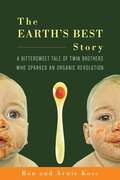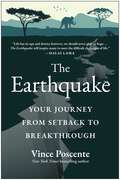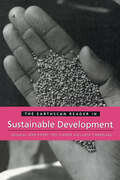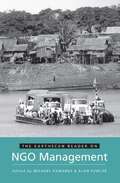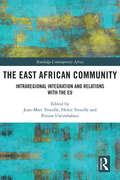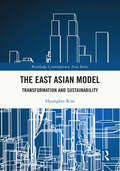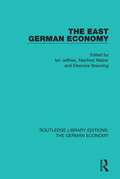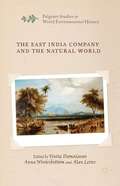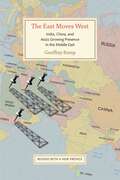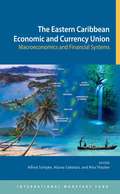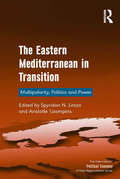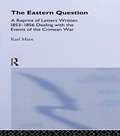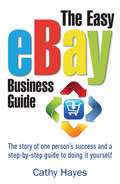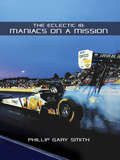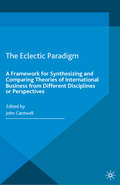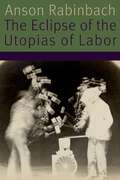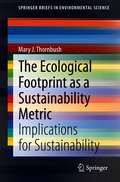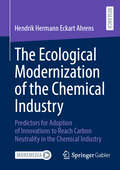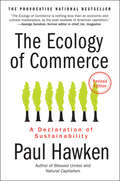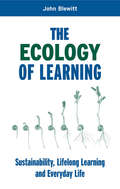- Table View
- List View
The Earth's Best Story
by Arnie Koss Ron KossThe Earth's Best Story tells how Ron and Arnie Koss succeeded in creating the first nationally distributed organic foods company to sit next to its mainstream competition on supermarket shelves-a step that revolutionized and empowered the organic-foods movement as a whole-and benefited hundreds of farmers as well as the millions of babies whose very first foods have been organically grown, thanks to Earth's Best. The Koss brothers, Ron and Arnie, had been sprout growers, broommakers, tool restorers, butlers, and natural-foods clerks, yet raised millions of dollars to start the first organic baby food company in the United States. How unlikely was that? The Earth's Best Story is a bittersweet tale about the founding of Earth's Best Baby Foods. Told through the dual narrative of each brother, this is not a business tome, although it is rich in entrepreneurial lessons and know-how. Rather, it's more like a "how to," "how not to," and "how they did it" memoir. it's personal, it's intense, it's inspirational, and it's full of reflections and tales of wonder and woe. People of every imaginable background and station in life want to make a difference with their lives. But how do you effectively do that? How does an idea successfully journey across the wastelands separating fantasy and reality? the Koss brothers take the reader on this journey. Theirs is a tale of idealism, naivetÉ, and possibility that reflects the quest to find a place in this world by somehow changing it For The better.
The Earthquake: Your Journey from Setback to Breakthrough
by Vince PoscenteFrom the New York Times bestselling author of The Age of Speed and The Ant and the Elephant comes an all-new parable to help you break free from feeling stuck and bounce back after a crisis. "Life has its ups and downs; however, we should never give up hope . . . The Earthquake will inspire many to meet the difficult challenges of life." —Dalai Lama The Earthquake is a must read for anyone looking to find their way to sustained hope. Use this book to find specific solutions to the setback you&’re currently facing or to help others bounce back from their personal earthquake. This parable will help readers to: Reframe dark times as illuminating experiences Resist the impulse to go it alone Find fresh perspectives Seek a path where you can enjoy the journey In this entertaining modern-day fable, Vince Poscente introduces us to the well-intentioned, conscious ant and the habitually fearful, subconscious elephant as seismic destruction changes their world and ultimately forces them to leave their oasis. What Adir the ant and Elgo the elephant learn—and what you&’ll learn by journeying with them—is the linear path they used to reach the oasis in The Ant and the Elephant does not work in the chaos after an earthquake. How can they breakthrough and thrive after a life-altering setback? This book offers prescriptive advice, and is based on Poscente&’s study of practices including: decoding human behavior the neuroscience of performance interpersonal dysfunction around fear
The Earthscan Reader in Sustainable Development (Earthscan Reader Series)
by Lloyd Timberlake John Kirkby Phil O’KeefeSuch a huge number of books, journals and papers have been devoted to defining, assessing and implementing 'sustainable development' that students and other readers face information overload. Earthscan alone has published hundreds of essays and books on the subject. Now, though, the most authoritative writings have been carefully assessed and collected together in the Earthscan Reader in Sustainable Development. The contributions included span five years of the debate, and cover all the principle themes: the history of the concept; the problems in defining it; the issues surrounding it; and national international policies and schemes to implement it. For ease of use, the essays have been split into key subject areas - such as agriculture, population and the commons - and they include practical case studies and examples, together with analyses from a number of different viewpoints from both the North and South. These seminal essays will provide readers with a unique overview of the subject, as well as the long-awaited basic course material for students of environmental studies, economics, geography, politics, planning and the social sciences.
The Earthscan Reader on NGO Management (Earthscan Reader Series)
by Michael Edwards Alan FowlerIn the last ten years, NGOs have become a force for transformation in global politics and economics. Their numbers and size have grown dramatically and they have assumed far more extensive responsibilities as intermediaries between governments, businesses and other institutions, and local communities and citizens. With this growth has come an ever-more pressing requirement for effective management among NGOs and their operations. Focusing on development organizations working on issues of poverty and injustice, but relevant to NGOs in all sectors, this volume brings together a selection of key writings on how NGOs can position and organize themselves to achieve maximum impact and effectiveness. The editors set out the management challenges facing NGOs in a stimulating Introduction followed by a range of contributions divided into ten sets of issues.
The East African Community: Intraregional Integration and Relations with the EU (Routledge Contemporary Africa)
by Jean-Marc Trouille, Helen Trouille and Penine UwimbabaziThis book brings together African and European experts from a variety of disciplines to examine the origins and current state of the East African Community (EAC). Over the course of the book, the authors analyse the rich tapestry of intraregional relations in East Africa, the EAC’s similarities with the European Union and the future challenges faced by the organisation. Widely regarded as the most advanced and successful regional integration scheme in Africa, the EAC is an intergovernmental organisation consisting of Burundi, Kenya, Rwanda, Tanzania, and Uganda and, since 2016, South Sudan. It is the oldest among Africa’s regional economic communities, and among the continent’s most promising growth areas, with a long history of integration, punctuated by several false starts and traumas that have profoundly affected its body politics. When initially set up, the EAC model bore a striking resemblance to the process undergone by the European Union. Now, as the EAC continues to establish its own identity, this book argues that whilst Europe’s history may provide useful insights for EAC member states, the EAC experience could in turn also offer lessons for the European Union. Covering key dimensions such as integration, co-operation, development, trade and investments, this book highlights the intricate and complex relationships between East African states, and it will be of interest to researchers working on economic development, international relations, peace and security and African studies.
The East Asian Model: Transformation and Sustainability (Routledge Contemporary Asia Series)
by Hyungkee KimHyungkee Kim analyses the model of East Asian development as it existed during periods of high growth and how it was transformed by pressures from both the Washington consensus and its own internal contradictions. Many have discussed the successes and failures of the East Asian model, but Kim is concerned rather with the story of its transformation, and its long-term sustainability. He uses a Five Sector Model, which focuses on the, state, corporate, financial, labour, and foreign sectors to identify the core of East Asian model and examine the variants in Korea, Japan and China. He also outlines the distinctions between the East Asian model and Western development models including the Anglo-American, Rhine, and Nordic models. He analyses in detail the institutional changes such as marketization, privatization, liberalization, and flexibilization that have transformed the East Asian model. Highlighting the major problems that emerged from the transformation of the East Asian model, Kim assesses its prospects for economic, social and ecological sustainability and proposes an agenda for institutional reforms. An essential reading for scholars of East Asian political economy.
The East German Economy: From Honecker To Reunification (Routledge Library Editions: The German Economy #6)
by Ian Jeffries Manfred Melzer Eleonore BreuningOriginally published in 1987, this book brings together leading authorities from Germany and the USA who analyze how the East German economy actually operated - planning and management, pricing, investment and innovation, the financial system, agriculture and foreign trade (including the special concessions granted by the then Federal Republic of Germany). The volume is an insightful study of one of the least studied and most successful of socialist economies.
The East India Company and the Natural World
by Vinita DamodaranThis book is the first to explore the deep and lasting impacts of the largest colonial trading company, the British East India Company on the natural environment. The contributors - drawn from a wide range of academic disciplines - illuminate the relationship between colonial capital and the changing environment between 1600 and 1857.
The East Moves West
by Geoffrey KempWhile traditionally powerful Western economies are treading water at best, beset by crises in banking, housing, and employment, industrial growth and economic development are exploding in China and India. The world's two most populous nations are the biggest reasons for Asia's growing footprint on other global regions. The increasing size and impact of that footprint are especially important in the Middle East, an economic, religious, and geopolitical linchpin. The East Moves West details the growing interdependence of the Middle East and Asia and projects the likely ramifications of this evolving relationship. It also examines the role of Pakistan, Japan, and South Korea in the region.Geoffrey Kemp, a longtime analyst of global security and political economy, compares and contrasts Indian and Chinese involvement in the Middle East. He stresses an embedded historical dimension that gives India substantially more familiarity and interest in the region--India was there first, and it has maintained that head start. Both nations, however, are clearly on the rise and leaving an indelible mark on the Middle East, and that enhanced influence has international ramifications for the United States and throughout the world.Does the emergence of these Asian giants--with their increasingly huge need for energy--strengthen the case for cooperative security, particularly in the maritime arena? After all, safe and open sea-lanes remain an essential component of mutually beneficial intercontinental trade, making India and China increasingly dependent on safe passage of oil tankers. Or will we see reversion to more traditional competition and even conflict, given that the major Asian powers themselves have so many unresolved problems and that the future of the U.S. presence in the area is uncertain. Kemp believes the United States will remain the dominant military power in the region but will have to share some security responsibilities with the Asians, especially in the Indian Ocean.
The East Moves West
by Geoffrey KempWhile traditionally powerful Western economies are treading water at best, beset by crises in banking, housing, and employment, industrial growth and economic development are exploding in China and India. The world's two most populous nations are the biggest reasons for Asia's growing footprint on other global regions. The increasing size and impact of that footprint are especially important in the Middle East, an economic, religious, and geopolitical linchpin. The East Moves West details the growing interdependence of the Middle East and Asia and projects the likely ramifications of this evolving relationship. It also examines the role of Pakistan, Japan, and South Korea in the region.Geoffrey Kemp, a longtime analyst of global security and political economy, compares and contrasts Indian and Chinese involvement in the Middle East. He stresses an embedded historical dimension that gives India substantially more familiarity and interest in the region-India was there first, and it has maintained that head start. Both nations, however, are clearly on the rise and leaving an indelible mark on the Middle East, and that enhanced influence has international ramifications for the United States and throughout the world.Does the emergence of these Asian giants-with their increasingly huge need for energy-strengthen the case for cooperative security, particularly in the maritime arena? After all, safe and open sea-lanes remain an essential component of mutually beneficial intercontinental trade, making India and China increasingly dependent on safe passage of oil tankers. Or will we see reversion to more traditional competition and even conflict, given that the major Asian powers themselves have so many unresolved problems and that the future of the U.S. presence in the area is uncertain. Kemp believes the United States will remain the dominant military power in the region but will have to share some security responsibilities with the Asians, especially in the Indian Ocean.
The Eastern Caribbean Central Bank: Challenges to an Effective Lender of Last Resort
by Pablo Druck Mario DehesaA report from the International Monetary Fund.
The Eastern Caribbean Currency Union Institutions, Performance, and Policy Issues
by Ruby Randall Frits Van Beek José Roberto Rosales Mayra Zermeño Jorge ShepherdThe Eastern Caribbean Central Bank is one of just a few regional central banks in the world and the only one where the member countries have pooled all their foreign reserves, the convertability of the common currency is fully self-supported, and the parity of the exchange rate has not changed. This occasional paper reviews recent developments, policy issues, and institutional arrangements in the member countries of the Eastern Caribbean Currency Union, and looks at the regional financial system, its supervision, and the central bank's initiatives to establish a single financial space. the paper includes a large amount of statistical information that is not readily available elsewhere from a single source.
The Eastern Caribbean Economic and Currency Union: Macroeconomics and Financial Systems
by Alfred Schipke Nita Thacker Aliona CebotariA report from the International Monetary Fund.
The Eastern Mediterranean in Transition: Multipolarity, Politics and Power (The International Political Economy of New Regionalisms Series)
by Aristotle Tziampiris Spyridon N. LitsasThe wider region of the Eastern Mediterranean is in transition. What is being evinced is a situation of continuous volatility, centering on developments such as the ’Arab Spring,’ the Greek sovereign debt crisis, Islamic terrorism, the continuation of deadlock over the Cypriot and Palestinian Issues, significant energy finds in the Levantine Basin, concerns over nuclear proliferation and, more recently, the Syrian Civil War. At a systemic level, the move towards a regional multipolar reality has also contributed to volatility by creating a crescendo of antagonisms between all the major international actors who continuously strive for more influence, power and prestige. This collective project by leading experts represents a unique combination of International Theory and International Politics analysis that deals exclusively with the wider Eastern Mediterranean. It scrutinizes in a multidimensional manner the current geostrategic and geopolitical conditions that include the latest domestic socio-political events, as well as the active involvement of the Great Powers in the region. This book should be of interest to academics, decision-makers and a general reading public focusing on a significant and influential region in flux.
The Eastern Question: A Reprint Of Letters Written 1853-1856 Dealing With The Events Of The Crimean War (classic Reprint) (Research And Source Works #No. 279)
by Karl MarxFirst Published in 1994. Routledge is an imprint of Taylor & Francis, an informa company.
The Easy eBay Business Guide: The Story Of One Person's Success And A Step-by-step Guide To Doing It Yourself
by Cathy HayesFrom a few bits and pieces in a dusty loft to a profitable business with more than 20,000 sales and turnover of £100,000.00 in just one year. This book not only tells the story of how the author went from being an eBay buyer to a Top Rated Platinum Powerseller with over 12,000 positive feedbacks, but also provides the reader with a step by step easy to follow guide to launching a successful eBay business. Drawing from the Author's own experiences and skills acquired in her first year trading this book will help the reader avoid the pitfalls and mistakes she made and fast track their new enterprise on the road to success.
The Easy eBay Business Guide: The story of one person's success and a step-by-step guide to doing it yourself
by Cathy HayesFrom a few bits and pieces in a dusty loft to a profitable business with more than 20,000 sales and turnover of £100,000.00 in just one year. This book not only tells the story of how the author went from being an eBay buyer to a Top Rated Platinum Powerseller with over 12,000 positive feedbacks, but also provides the reader with a step by step easy to follow guide to launching a successful eBay business. Drawing from the Author's own experiences and skills acquired in her first year trading this book will help the reader avoid the pitfalls and mistakes she made and fast track their new enterprise on the road to success.
The Eclectic 18: turbo articles, riveting reviews, inspiring life insights from unique books, movies, broadcasts, and race events critiqued in Radioactive Drag Racing News
by Phillip Gary SmithWhat’s it like to be a maniac on a mission? From the worlds of performance engineering, product development, drag racing, auto racing and human creativity, go beyond with THE ECLECTIC 18. Learn tipping points key to the success of The Justice Brothers oil empire uncovered only here. Realize lessons from Funny Car NHRA pioneer John Force’s rise to racing supremacy and how his success - and failures - may improve your life. Discover the “Top Ten Tommy Teachings,” shocking ways to survive absolute terminal cancer from one driven competitor. Absorb how a car known as Big Noise II dominated a man’s life and a tragedy. What about “My First Car” of yours; how does it stack up against Hugh Hefner’s, Steve McQueen’s, and many others you will know? Just try to be as big and creative in your thinking as “TV Tommy Ivo, Drag Racing’s Master Showman.” Take to heart a real maniac on a mission: “Mickey Thompson, the Fast Life and Tragic Death of a Racing Legend.” Use these readings for their lessons in life, then apply them. Joyfully “Dance the Western Swing,” “Light the Dark,” plus recognize what happens when one doubles down in Vegas with nitro chips. Understand the spectacle resulting “When 10000 Horsepower Goes Wrong.” With THE ECLECTIC 18 you, too, may just be one of “The New Kids on the Winner’s Block” of life. Find deeper meanings and helpful insights on striving to succeed and becoming relevant that also entertains. “THE ECLECTIC 18 traded the safety of emotional equilibrium for their compulsion to unabashedly collide with life’s vicissitudes with unrelenting verve.” Jeff Kildahl, Ph.D., Creator and President, The Wholistic Edge®
The Eclectic Paradigm: A Framework for Synthesizing and Comparing Theories of International Business from Different Disciplines or Perspectives (JIBS Special Collections)
by John CantwellTo help to promote a greater conversation between those interested in the theoretical explanation of IB activities from various different backgrounds or starting points, this book offers a special Collection of JIBS articles which concern the foundations and the application of the eclectic paradigm.
The Eclipse of the Utopias of Labor (Forms of Living)
by Anson RabinbachThe Eclipse of the Utopias of Labor traces the shift from the eighteenth-century concept of man as machine to the late twentieth-century notion of digital organisms. Step by step—from Jacques de Vaucanson and his Digesting Duck, through Karl Marx’s Capital, Hermann von Helmholtz’s social thermodynamics, Albert Speer’s Beauty of Labor program in Nazi Germany, and on to the post-Fordist workplace, Rabinbach shows how society, the body, and labor utopias dreamt up future societies and worked to bring them about. This masterful follow-up to The Human Motor, Rabinbach’s brilliant study of the European science of work, bridges intellectual history, labor history, and the history of the body. It shows the intellectual and policy reasons as to how a utopia of the body as motor won wide acceptance and moved beyond the “man as machine” model before tracing its steep decline after 1945—and along with it the eclipse of the great hopes that a more efficient workplace could provide the basis of a new, more socially satisfactory society.
The Ecological Footprint as a Sustainability Metric: Implications for Sustainability (SpringerBriefs in Environmental Science)
by Mary J. ThornbushThis book examines the Ecological Footprint and biocapacity accounting within an applied development content for Costa Rica. By doing so, it is possible to track changes as well as perhaps link these to overarching global issues, such as trade, globalization, and food security, among other emergent topics based findings stemming from this methodology. Based on a timeseries since 1961, it is possible to track cross-temporal changes of land-type categories (for crop land, grazing land, forest land, fishing ground, built-up land, and carbon) of the Ecological Footprint and biocapacity conveying whether a country is in ecological deficit and what may be contributing to such a trend
The Ecological Modernization of the Chemical Industry: Predictors for Adoption of Innovations to Reach Carbon Neutrality in the Chemical Industry
by Hendrik Hermann AhrensIn this book key predictors of renewable feedstock adoption to achieve carbon neutrality in the European chemical industry are explored. Systematic data collection for the analysis was conducted through semi-structured expert interviews and document analysis, validating existing theories, including agent-based models of innovation diffusion, the multi-level perspective of socio-technical transition and technological innovation systems. The research findings led to insights on the key predictors of renewable resource adoption and support practitioners to manage the transition to carbon neutrality.
The Ecology of Commerce Revised Edition: A Declaration of Sustainability
by Paul HawkenThe Ecology of Commerce is the provocative national bestseller that addresses the necessity of merging good business practices with common sense environmental concerns. Nearly two decades after its initial publication, this controversial work by Paul Hawken has been revised and updated, arguing why business success and sustainable environmental practices need not—and, for the sake of our planet, must not—be mutually exclusive any longer. An essential work, Hawken’s The Ecology of Commerce belongs on the bookshelf of every concerned citizen—alongside Capitalism at the Crossroads by Stuart Hart and Al Gore’s Earth in the Balance and An Inconvenient Truth.
The Ecology of Commerce: A Declaration of Sustainability
by Paul HawkenA visionary new program that businesses can follow to help restore the planet.
The Ecology of Learning: "Sustainability, Lifelong Learning and Everyday Life"
by John BlewittYour house is flooded by 'unseasonal' heavy rain. What do you learn from this experience? Do you shrug your shoulders and call your insurer? Or do you choose to learn about climate change, switch to renewable energy and lobby politicians? In this insightful book, John Blewitt explores the possibilities for developing a sustainable society through 'lifelong learning' ? that is, learning that happens in everyday environments and activities as diverse as shopping, community, 'edutainment', information and communication technology, the internet, broadcasting, people's experience of place and space, green building, social networks and consumer culture. Drawing on a range of sociological, anthropological and educational studies as well as new research, The Ecology of Learning is ideal for educators, teachers, corporate trainers and consultants working to integrate environmental education, sustainability and innovation in non-traditional learning situations. The coverage is extensive, with an accessible but informed engagement with both theory and practice and a wide range of examples. Throughout, the voices, stories and experiences of many people are used to illustrate the ways people may reshape our understanding of learning and sustainability.
